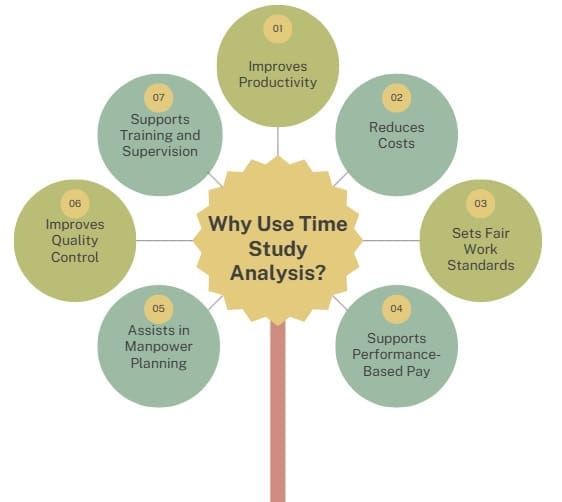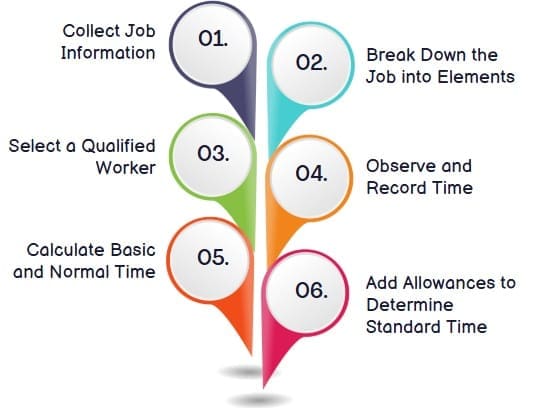Time study analysis is a method of directly observing and recording the time taken to perform a task. It involves using a Companies use tools like a stopwatch, video camera, or electronic timer to measure how long different elements of a job take to complete. Indeed, the main goal is to find the standard time—the time a trained worker should normally take to complete a task using a specified method at a steady pace.
Time study is especially useful when:
- Tasks are repetitive, whether short or long in duration.
- A variety of different jobs are performed regularly.
- A task includes machine-controlled or process-controlled elements.
Therefore, by breaking down tasks into smaller parts and timing them, companies can identify inefficiencies and make data-based decisions to improve workflow and reduce costs.
Table of contents
Origins of Time Study
The concept of time study was pioneered by Frederick Winslow Taylor, known as the father of scientific management. Specifically, in the early 20th century, Taylor worked with factory managers to develop more efficient ways of performing industrial tasks. He broke down each job into steps, measured how long each step took, and suggested better ways of organizing work.
Fundamentally, Taylor believed management should rely on data and analysis rather than tradition or guesswork. He proposed performance-based pay systems where workers would earn more if they completed tasks faster—based on scientifically established standards. Thus, his work laid the foundation for modern time study and performance improvement.
Public, Onsite, Virtual, and Online Six Sigma Certification Training!
- We are accredited by the IASSC.
- Live Public Training at 52 Sites.
- Live Virtual Training.
- Onsite Training (at your organization).
- Interactive Online (self-paced) training,
Time Study vs. Motion Study
People often confuse time study with motion study, but they are not the same. Specifically, time study focuses on how long a task takes, while motion study looks at how a task is done. In motion study, the aim is to eliminate unnecessary movements and design tasks to be as smooth and efficient as possible.
Nevertheless, the two methods are related. In fact, together, they form what experts often call methods engineering—the science of analyzing and improving work processes. Ultimately, both time and motion studies share a common goal: to increase productivity without increasing stress or effort.
Also Read: Survival Analysis
What is Work Measurement?
Work measurement is a systematic way of determining how long it takes for a worker to complete a task. It includes several techniques to identify and analyze how time is spent during a job cycle. The ultimate goal is to establish a standard time—a benchmark for how long a job should take when performed by a trained worker using a prescribed method.
Fredrick Winslow Taylor, often called the father of scientific management, introduced many of these ideas. He emphasized breaking work into smaller elements, measuring them, and identifying areas to eliminate wasteful or non-productive time.
Challenges in Measuring Work
Work measurement isn’t easy. Human factors such as motivation, fatigue, boredom, and anxiety can greatly affect performance. Skill levels, confidence, and attitude also vary from one worker to another. Additionally, physical and environmental factors—like temperature, lighting, noise, dust, and vibrations—can influence how efficiently a task is done.
These variables make it difficult to set a perfect standard, but through careful observation and analysis, companies can get close enough to make informed decisions.
What is Time Study?
Time study is a specific method of work measurement. It involves observing a job, dividing it into smaller parts (called elements), timing each element with a stopwatch or digital timer, and calculating how long it should ideally take to perform. By using this method, organizations can set standard times for tasks, improve productivity, and control labor costs.
The International Labour Organization (ILO) defines time study as:
“A work measurement technique for recording the times and rates of working for the elements of a specified job carried out under specified conditions and for determining the time needed at a defined level of performance.”
Also Read: Time Series Analysis
Why is Time Study Important?
Time study is more than just timing a task. It offers several practical benefits:
- Helps plan and schedule work efficiently.
- Improves labor cost control and budgeting.
- Supports accurate costing and pricing of products.
- Assists in setting fair performance-based wage systems.
- Improves machine utilization and workforce allocation.
- Aids in balancing assembly lines and streamlining production.
Why Use Time Study Analysis?

Time study is a versatile tool that offers many advantages for both employers and workers. Here are some key reasons to use it:
- Improves Productivity
By analyzing tasks and removing time-wasting steps, businesses can get more done in less time. - Reduces Costs
When workers organize tasks more efficiently, they need fewer resources to complete the same amount of work. - Sets Fair Work Standards
Workers benefit from having clear, achievable expectations. Time study helps set fair targets and avoid overwork. - Supports Performance-Based Pay
Time-based standards can form the basis for bonuses, incentives, or promotions based on performance. - Assists in Manpower Planning
Organizations use time study to calculate how many workers they truly need for specific workloads. - Improves Quality Control
Consistent and efficient task performance reduces the chances of errors. - Supports Training and Supervision
Managers and trainers can use time study results to teach new workers and monitor ongoing performance.
Tools and Equipment Used in Time Study
To conduct a time study effectively, the following tools are commonly used:
- Stopwatch or digital timer – Records time accurately.
- Time study board – Holds the study sheets for easy writing.
- Time study forms – Used to record data and job information.
- Pencils, erasers, and calculators – Help in recording and computing.
- Measuring tools – Including tapes, rulers, micrometers, spring balances, and tachometers (for speed).
Modern versions may also use video recordings or electronic data collectors to increase precision and reduce observer bias.
Also Read: What is Cycle Time Reduction?
Steps in Conducting a Time Study

The time study process follows a structured method to ensure accurate results. Here’s how it’s typically done:
Step 1: Collect Job Information
Start by gathering all necessary data about the task:
- Product and material details.
- Process description, including tooling and machinery.
- Operator’s qualifications, experience, and skill.
- Environmental conditions like temperature, humidity, and lighting.
Step 2: Break Down the Job into Elements
Analyze the job and divide it into logical, measurable parts. These are called elements. For example, a turning operation on a lathe might include:
- Fixing the workpiece in the chuck.
- Centering and tool setting.
- Performing the turning.
- Removing the job from the chuck.
Each element should be:
- Short enough to measure accurately.
- Clearly defined.
- Either machine-controlled or man-controlled (not both).
- Repetitive or non-repetitive as needed.
- Classified as productive or non-productive.
Step 3: Select a Qualified Worker
Choose a worker who represents an average skill level—neither an expert nor a beginner. The organization should train the worker well in the prescribed method to ensure the time recorded reflects typical performance.
Step 4: Observe and Record Time
Use a stopwatch or timer to observe the time taken for each element. Do this several times to eliminate anomalies and average out the performance. Each observation is recorded on a time study sheet.
Step 5: Calculate Basic and Normal Time
To find the basic time, average the observed times for each element.
Next, determine the normal time using this formula:
Normal Time = Basic Time × Performance Rating Factor
The performance rating compares how fast or slow the worker was to the standard pace.
Step 6: Add Allowances to Determine Standard Time
No worker can work continuously without breaks. You must account for:
- Personal needs (bathroom, water, etc.)
- Fatigue (rest periods)
- Delays (machine stoppages, tool changes)
To get the standard time, use the following formula:
Standard Time = Normal Time × (100 / (100 – Allowance %))
This gives a realistic, achievable benchmark for how long a task should take.
Extended or Long-Term Time Study
Sometimes, it’s necessary to conduct a continuous time study over one or more work shifts. This helps check the accuracy of existing time standards or gather deeper insights into time-related issues that affect output. Such studies are more detailed and often include work sampling and performance logs.
Applications of Time Study in Industry
Time study is used across many functions in an organization:
- Production Planning: It helps plan job schedules and resource allocation.
- Costing and Estimating: Time standards allow companies to estimate labor costs and prepare accurate bids or quotations.
- Performance Evaluation: It supports merit-based wage systems and productivity-based incentives.
- Quality Control: When analysts time and standardize jobs, they can quickly identify problems through any deviations in the process.
- Line Balancing: In assembly lines, time study ensures each workstation has equal workloads, minimizing idle time.
Time Study vs. Other Methods
While time study is the most widely used method, it’s not the only one. Other work measurement techniques include:
- Predetermined Motion Time Systems (PMTS): Use standard times for basic motions (like reach, grasp, move).
- Work Sampling: Involves taking random observations over time to estimate the proportion of time spent on different tasks.
- Standard Data Systems: Use historical data to assign time values to common tasks.
- Synthesis: Combines elements from various studies to estimate job times.
Time study remains popular because of its simplicity, flexibility, and ability to provide detailed and direct insight into job performance.
Tips for Effective Time Study
To get the most accurate results from a time study:
- Use trained observers who understand the job process.
- Make sure the worker is not under pressure and understands the study’s purpose.
- Choose the right number of observations to get reliable averages.
- Avoid errors like observer bias, wrong stopwatch handling, or poor time recording.
- Double-check measurements and calculations.
Common Challenges in Time Study
While time study is valuable, it comes with some challenges:
- Worker Resistance: Employees may feel they are being judged or rushed.
- Observer Error: Inexperienced observers can make timing mistakes.
- Changing Conditions: Time measured on one day may not reflect future work due to changes in volume or equipment.
- Human Variation: Fatigue, skill, and motivation levels differ, even among trained workers.
To minimize these issues, organizations must communicate openly with workers, use trained analysts, and repeat measurements over time.
Final Words
Time study analysis plays a vital role in modern production and service industries. It enables businesses to understand how work is performed, identify inefficiencies, and set realistic time standards.
Although influenced by many human and environmental factors, a carefully conducted time study provides a solid foundation for improving productivity, ensuring fair wages, and streamlining operations.
By following a systematic approach—collecting job information, breaking tasks into elements, observing time, and calculating standard time—companies can make informed decisions that lead to better resource utilization and employee satisfaction. Ultimately, with the right tools and mindset, time study becomes a powerful tool for operational excellence.

About Six Sigma Development Solutions, Inc.
Six Sigma Development Solutions, Inc. offers onsite, public, and virtual Lean Six Sigma certification training. We are an Accredited Training Organization by the IASSC (International Association of Six Sigma Certification). We offer Lean Six Sigma Green Belt, Black Belt, and Yellow Belt, as well as LEAN certifications.
Book a Call and Let us know how we can help meet your training needs.



















